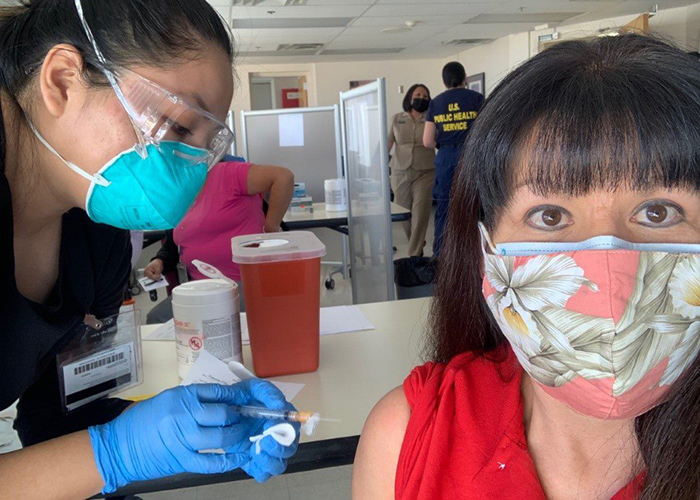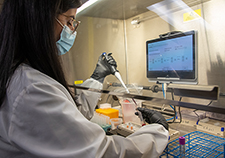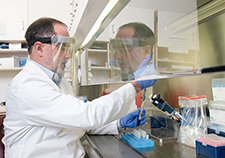Office of Research & Development |
 |


Theresa Clay (right), a member of Navajo Nation, receives her COVID-19 vaccine booster shot from a nurse with the Indian Health Service (IHS), Shayla Jim, during a recent IHS vaccination event in Albuquerque. (Photo courtesy of Indian Health Service)
March 11, 2021
By Mike Richman
VA Research Communications
"I thank the Department of Veterans Affairs for working with the Indian Health Service in the Albuquerque area because we lacked an infrastructure for that type of ultra-cold storage."
Santa Clara Pueblo in northern New Mexico is one of nearly two dozen sovereign tribal nations in the state. Like many other American Indian and Alaska Native communities, the Pueblo Indians have been hit hard by the novel coronavirus.
About 125 of the 2,500 residents on the Santa Clara Pueblo reservation have been infected with COVID-19 virus. Several tribal members have passed away due to the virus and its devastating complications.
In the eyes of Santa Clara Pueblo Governor Michael Chavarria, the pandemic has been “detrimental” to every tribal nation in New Mexico.

AI to Maximize Treatment for Veterans with Head and Neck Cancer

VA researcher works to improve antibiotic prescribing for Veterans

VA’s Million Veteran Program played crucial role in nation’s response to COVID-19 pandemic

VA Further Develops Its Central Biorepository: VA SHIELD
“COVID-19 was new to all of us, so we really didn’t know how to combat this unfortunate incident,” he says. “Because we don’t have grocery stores for folks to get daily necessities, they have to venture off our lands and are possibly infected before coming home. We have multi-generational housing with up to eight people from the youngest to mom, dad, grandpa, and grandma. Those living conditions have led to a high rate of spread. We lacked education through doctors, health professionals, and scientists in the beginning to be fully aware how to protect one another.”
VA has pitched in to help. At the request of the Albuquerque area office of the U.S. Indian Health Service (IHS), a clinical research center affiliated with the New Mexico VA Health Care System in Albuquerque is storing vials of the Pfizer-BioNTech COVID-19 vaccine in its ultra-cold freezer system. The vaccine must be stored at temperatures of minus 60 degrees Celsius to minus 80 degrees Celsius. Without a proper ultra-cold freezer system, IHS officials turned to the New Mexico VA for assistance.
Santa Clara Pueblo has since become one of 27 Native American reservations in the Southwest states of New Mexico, Colorado, Texas, and Utah—the region under the purview of the Albuquerque IHS—to receive doses of the Pfizer vaccine stored at the New Mexico VA. About 500 residents of the Santa Clara Pueblo reservation have been vaccinated thus far, with half receiving the Pfizer vaccine and the other half the Moderna vaccine. Vials of the latter are stored in normally refrigerated temperatures. The U.S. Centers for Disease Control and Prevention (CDC) is allocating and distributing the vaccines to the Albuquerque IHS.
The Pfizer and Moderna vaccines, which each require two shots up to four weeks apart, are believed to be about 95% effective in preventing one from getting COVID-19.
In November, the chief medical officer of the Albuquerque IHS, Dr. Juliana Reece, reached out to New Mexico VA Director Andrew Welch for aid with an ultra-low temperature freezer to store the Pfizer vaccine. Welch contacted the clinical research center, which crafted a plan with IHS to receive, store, and distribute the vaccine. The research center stores biospecimens in more than 90 of the ultra-low freezers. Only one of the freezers has been needed to store the Pfizer vaccine.
The freezers, which are much larger than a standard household refrigerator, can each store about 40,000 vials. Every vial contains up to six doses of the vaccine. About 70,000 doses have been administered thus far.
“These ultra-low temperature freezers are hard to come by,” says Rob Ringer, director of the biorepository at the clinical research center in Albuquerque. “Not everybody has them.”
The Indian Health Service, a federal agency within the Department of Health and Human Services, is responsible for providing health services to American Indians and Alaska Natives. In recent months, IHS has been coordinating the distribution of COVID-19 vaccines to IHS , tribal, and urban Indian facilities that have chosen to receive vaccines. According to the CDC, infection rates in American Indian and Alaska Native communities are over 3.5 times higher than non-Hispanic whites. Indigenous people are also more than four times more likely to be hospitalized because of COVID-19.
The population of Native Americans in the four-state region under the Albuquerque IHS is 81,000. Capt. Wil Darwin, the Albuquerque area IHS vaccine coordinator, expects that everyone who is willing and eligible will be vaccinated over the next few months.
At the Santa Clara Pueblo reservation, the challenge of social distancing in the home and the need to go off the reservation to shop for necessities and seek other services have factored into the infection of some of the residents, Michael Chavarria notes. The Pueblo Indians are like many other Native American communities with a multi-generational family arrangement in cramped homes.
“For us as Pueblo people, grandpa and grandma took care of us, so we don’t like to send them to old age homes or day care facilities,” Chavarria says. “It’s our time to take care of them. The best way is to keep them in the same household so they can continue to pass on our language, our tradition, and our culture, and to tell stories to the younger generation. That’s part of our education.”
The lack of a broadband-internet connection in the homes to facilitate telehealth, tele-education, and telework has also been a critical issue. Without that type of infrastructure, Chavarria explains, it’s been difficult for people to have virtual health care appointments.
“That has caused tremendous burden on our folks in having to venture off Pueblo land to seek those types of health care necessities,” he says.
Chavarria commends VA for “stepping up to the plate.”
“I thank the Department of Veterans Affairs for working with the Indian Health Service in the Albuquerque area because we lacked an infrastructure for that type of ultra-cold storage,” he says. “This is critical. It pertains to the government’s relationship with politically sovereign governments to fully support and think outside the box and leverage internal resources to provide a potential positive outcome for all of us during this unfortunate time in our lives.”
VA Research Currents archives || Sign up for VA Research updates